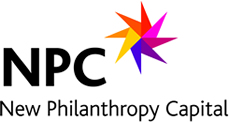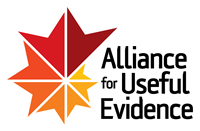Resource Centre
- Four essentials for evaluation, Grantmakers for Effective Organisations (United States)
The guide seeks to provide grantmakers with ideas and insights so they can develop and strengthen their evaluation capacities in four areas: leading, planning, organising and sharing;
- Impact measurement as an entrepreneurial process, Prof. Fergus Lyon and Dr. Malin Arvidson, Third Sector Research Centre (United Kingdom)
This paper sets out to question why organisations embark on social impact measurement exercises; what guides decisions regarding the way organisations choose to investigate their social impact and how they use the results;
- Impact reporting in the UK Charity Sector, Charity Finance Group and Cass Business School (United Kingdom),
This report commissioned by Charity Finance Group explores the current state of impact reporting in the UK charity sector.
- Investing for impact: How social entrepreneurship is redefining the meaning of return, Credit Suisse and the Schwab Foundation for Social Entrepreneurship (Switzerland),
The report covers the latest trends shaping the field of Impact Investing, including the promise and risks of scaling growth for social enterprises, the importance of the right mix of financing structures to achieve scale, the development of standardized metrics, as well as lessons learned;
- Principles for good impact reporting for charities and social enterprises, ACEVO, Charity Finance Group, Institute of Fundraising, NCVO, New Philanthropy Capital, Small Charities Coalition, Social Enterprise UK, SROI Network (United Kingdom)
Using 6 key principles, this document seeks to help charities and social enterprises understand how they should communicate their impact and what they should communicate;
- Social Impact Assessment - A discussion among grant-makers, Rockefeller and Goldman Sachs Foundations (United States)
This paper summarises the outcomes from a meeting of over fifty funders who met to discuss the issues surrounding social impact assessment;
- Valuing social impacts: Should government pay for results?, PwC UK’s Public Sector Research Centre (United Kingdom)
This Talking Points publication, the first in a series of three, provides an approach to measuring social impacts and looks at practical steps to achieve wider adoption of Payment by Results schemes across government and the public sector;
- Impact measurement approaches: recommendations to impact investors and Catalogue of approaches to impact measurement: Assessing social impact in private ventures, Sara Olsen and Brett Galimidi, Social Venture Technology Group (United States)
This recommendation document and guide to existing methodologies for social investors lists 25 of the most widely used approaches for measuring social impact in the investment world;
- Developing effective ex ante social impact assessment with a focus on methodology, tools and data sources, Mike Brewer, Institute of Social and Economic Research, University of Essex (United Kingdom),
The purpose of the 2011 Peer Review in Brussels is to discuss how Member States can best develop effective ex ante social impact assessment; the intention is to focus the discussion on methodology, tools and data sources, rather than on processes, structures, or measures to stimulate demand for SIAs;
- Double bottom line project report: Assessing social impact in double bottom line ventures, Catherine Clark of Columbia Business School, William Rosenzweig of the Haas School of Business, David Long of Abt Associates and Sara Olsen of SVT Consulting (United States)
As part of the Double Bottom Line project, this guide lists and compares nine methods to define, measure and report social returns for investors;
- Good enough guide - Impact measurement and accountability in emergencies, Emergency Capacity Building Project (International);
The Good Enough Guide helps busy field workers to address the questions: What difference are we making? How do we know? It offers a set of basic guidelines on how to be accountable to local people and measure programme impact in emergency situations. Its ‘good enough’ approach emphasises simple and practical solutions and encourages the user to choose tools that are safe, quick, and easy to implement;
- The Green Book, HM Treasury (United Kingdom)
The Green Book offers guidance from the UK government on how to value social impact;
- Impact assessment guidelines, European Commission (EU);
Guidelines for European Commission staff preparing impact assessments, published in January 2009.
- Impact evaluation - the experience of the Independent Evaluation Group of the World Bank, The Independent Evaluation Group (International)
This report provides context to the general discussion surrounding impact evaluation and the variety of approaches available for impact evaluation as well as four case studies;
- Magenta Book, HM Treasury (United Kingdom)
The Magenta Book provides the UK government’s guidance for programme and project evaluation;
- Measuring social value, social outcomes and impact, National Association for Voluntary and Community Action (United Kingdom)
This report from NAVCA offers some of the approaches small charities can use to begin measuring and reporting their impact;
- Learning for Social Impact, McKinsey & Co (United States)
Developed by McKinsey’s Social Sector Officer this site seeks to help funders, their grantees, and other essential partners achieve social change by offering best practices, guidelines, tools, insights, and practical help in developing assessment plans that drive social impact;
- The Social Return on Investment (SROI) guide,SROI Network (International)
The updated 2012 guide to Social Return on In Investment (SROI) goes through the process in stages and outlines its key principles. The guide is available in several other languages;
- Study on social impact assessment, The Evaluation Partnership and CEPS on behalf of the European Commission (EU),
This study was commissioned by the European Commission (DG EMPL) to support mutual learning on social impact assessment within the Open Method of Coordination on Social Protection and Social Inclusion (OMC SPSI).
- Standards of Evidence for Impact Investing, Nesta, (United Kingdom)
Too often evidence of impact is missing from Impact Investing. Evidence is needed to establish whether a product or service is benefitting those it sets out to serve, and then to focus investment on products and services that can make the most difference. To help Nesta achieve this, they have developed a new approach, the Standards of Evidence for Impact Investing.
REPORTING
- Phineo (Germany);
- Sample Impact Assessment report from Shujog (Singapore);
METHODOLOGIES, APPROACHES, TOOLS
- Tools and Resources for Assessing Social Impact (TRASI), Foundation Center in partnership with McKinsey & Co. (USA)

TRASI is an expert-reviewed database of over 150 approaches to measuring the impact of social programs and investments. It also features a community portal for nonprofits, grantmakers, and social enterprises to connect with peers and evaluation experts.
- ‘The Good Analyst’, Adrian Hornsby of Investing for Good (United Kingdom)
In addition to providing a useful summary of the current debate around social impact in the UK’s charity sector, the book offers a detailed breakdown of the approach used by the social investment advisors Investing for Good in assessing the social impact of organisations. It also offers some general guidance for organisations beginning to think about measuring and reporting their impact;
- How the British Council (UK) evaluates impact, British Council (United Kingdom)
Detailing the background to the British Council’s approach, this presentation also outlines the indicators the organisation uses and how it seeks to report impact;
- Impact reporting and investment standards, the Global Impact Investing Network (International)
Paper detailing the background and specific benefits of the IRIS standards for reporting the social and environmental performance of impact investments;
- Midot (Israel);
- Outcomes Star, Triangle Consulting (United Kingdom)
The Outcomes Star frameworks, initially designed to captures outcomes in the housing sector, now cover fourteen different sectors to help measures social change. To find out more about how the Stars were developed, you can read The Development of the Outcomes Star: A Participatory Approach to Assessment and Outcome Measurement by Triangle Consulting’s Joy MacKeith;
- Really telling accounts! Report on a social accounting and audit research project, John Pearce and Alan Kay, Social Audit Network (United Kingdom),
The main purpose of this research has been to explore to what extent social accounting and audit has been used by social economy organisations in the North East of England, Cumbria, Merseyside and Scotland, to understand the perceived barriers to expanding its practice and how it may be made more “do-able” and more robust;
- The Social Return on Investment (SROI) guide, SROI Network (International)
The updated 2012 guide to Social Return on In Investment (SROI) goes through the process in stages and outlines its key principles. The guide is available in several other languages;
- What is the relationship between IRIS and SROI?, The SROI Network (International),
This paper discusses how the SROI (Social Return on Investment) method can be used in conjunction with the IRIS (Impact Reporting and Investment Standards) standardized performance indicators to help an organization understand its impact in a credible and comparable way.
- Measuring Well-being: A guide for practitioners, The new economics foundation (International)
This handbook provides tools for thinking about well-being and its measurement.
Part I of this handbook is Understanding Well-being and part II describes nef’s recommended practical tools for measuring well-being.
- Small Slices of a Bigger Pie: Attribution in SROI, The new economics foundation (International)
This report develops the methodology on understanding ‘attribution’ within a Social Return on Investment analysis. It’s objective is to understand the role of an intervention or organisation in creating change in people’s lives. Not just what that change is.
- Seven Principles for Measuring what Matters: A guide to effective public policy-making, The new economics foundation (International)
This report from the Measuring What Matters programme sets out to develop ways of measuring and valuing that will help build effective public services. Research across three very different policy areas - economic development, children in care, and criminal justice - found that making visible and valuing the outcomes that matter most to individuals, communities and society leads to more informed policy-making.
- Learn, Test, Adapt -Developing Public Policy with Randomized Controlled Trials, Cabinet Office (United Kingdom)
This Cabinet Report outlines the benefits of using Randomized Controlled Trials to test the effectiveness of public policy interventions.
- ‘A Journey to Greater Impact’, New Philanthropy Capital (United Kingdom)
This report from NPC charts the progress made by six charities to measuring their impact better;
- Action for Children impact report 2011 (United Kingdom);
- Bromley By Bow Centre’s impact report 2011 (United Kingdom);
- Knowing and showing your outcomes and impact, Sandra Velthuis and The Wheel (Ireland)
Based on interviews with a range of social purpose organisations, this report details the current state of social impact adoption in Ireland;
Charity Finance Directors’s (UK) ‘Principles Into Practice’ report in collaboration with ACEVO and New Philanthropy Capital;
- Counting on uncertainty: The economic case for community based adaptation in North-East Kenya, new economics foundation (International)
Through an analysis of community based adaptation within the framework of the Adaptation Learning Programme (ALP), of which CARE International is the implementer, this study aimed to assess whether investing in community based adaptation is economically efficient and effective. Two communities in Garissa County, North East Kenya, one pastoral and one agro-pastoral, were consulted to provide case studies within a broader objective to investigate the case for investing in community based adaptation.
- Unlocking Value: How we all benefit from investing in alternatives to prison for women offenders, new economics foundation (International)
nef”s research found that for every pound invested in support-focused alternatives to prison, £14 worth of social value is generated to women and their children, victims and society generally over ten years.
- Punishing Costs: How locking up children is making Britain less safe, new economics foundation (International)
This report outlines a policy that suggests ways to use money currently spent on incarceration more effectively, to produce a safer and more inclusive society.
- Making An Impact, New Philanthropy Capital (United Kingdom)
Making an impact offers the first representative picture of the charity sector’s response to the challenge of impact measurement.
- Housing providers: evidencing their impact, half-day discussion in partnership with HACT, 7 June 2012 (United Kingdom);
- Roundtable discussion: reconciling different approaches to social impact, evening event in collaboration with the Erasmus Centre for Strategic Philanthropy, 11 April 2012 (The Netherlands);
- Social impact in the Irish voluntary sector, half-day event in partnership with Philanthropy Ireland, 23 May 2012 (Rep. of Ireland);
- Social impact for the voluntary and community sectors, evening discussion in collaboration with the London Voluntary Sector Council, 17 May 2012 (United Kingdom);
- The Social Value Act: Implications for Local Government, breakfast seminar in collaboration with the New Local Government Network (NLGN), 3 July 2012 (United Kingdom);
- ANDE’s Metrics and Impact webpage (United States);
- Developing effective ex-ante social impact assessment with a focus on methodologies, tools and data-sources (European Union);
- Guidance on evaluation webpage, European Commission (European Union);
- Jargonbusters, Charities Evaluation Services in partnership with other third sector organisations (United Kingdom);
- An Introduction to Social Impact Bonds, McKinsey & Co (United States).
- Post-conference information from the ‘Prove Your Impact’ event, Cornwall Youth Work Partnership (United Kingdom) Draws together resources from the conference including presentations from Big Lottery Fund, Bristol University and the South West Forum among others.
- New economics for impact investing, nef economics foundation (International)







+44 (0)207 438 2598
[email protected]
Follow us on Twitter
Join us on LinkedIn
Join us on Facebook
Our photos on Flickr
Subscribe to our Feed